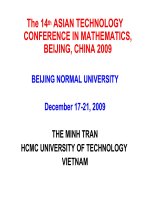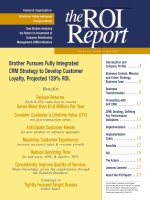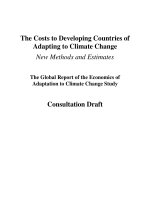The Brand Report Card
Bạn đang xem bản rút gọn của tài liệu. Xem và tải ngay bản đầy đủ của tài liệu tại đây (367.86 KB, 23 trang )
The Brand Report Card
Executive Summary
MOST MANAGERS RECOGNIZE
the value in building
and properly managing a brand. But few can objectively
assess their brand’s particular strengths and weaknesses.
Most have a good sense of one or two areas in which
their brand may excel or may need help. But, if pressed,
many would find it difficult even to identify all the factors
they should be considering.
To give managers a systematic way to think about
their brands, Tuck School professor Kevin Lane Keller
lays out the ten characteristics that the strongest brands
share. He starts with the relationship of the brand to the
customer: The strongest brands excel at delivering the
benefits customers truly desire, he says. They stay rele-
vant to customers over time. Pricing truly reflects con-
sumers’ perceptions of value.
1
HBR033ch1 1/16/02 3:02 PM Page 1
Keller then moves on to consider marketing strategy
and implementation: Strong brands are properly posi-
tioned. The brand stays consistent. Subbrands relate to
one another in an orderly way within a portfolio of
brands. A full range of marketing tools are employed to
build brand equity.
Finally, he looks at management considerations:
Mangers of strong brands understand what the brand
means to customers. The company gives the brand proper
support and sustains it over the long term. And the com-
pany consistently measures sources of brand equity.
By grading a brand according to how well it
addresses each dimension, managers can come up with
a comprehensive brand report card. By doing the same
for competitors’ brands, they can gain a fuller under-
standing of the relative strengths of their own brands in
the marketplace.
B
brand equity
has become a priority for companies of all sizes, in all
types of industries, in all types of markets. After all, from
strong brand equity flow customer loyalty and profits.
The rewards of having a strong brand are clear.
The problem is, few managers are able to step back
and assess their brand’s particular strengths and weak-
nesses objectively. Most have a good sense of one or two
areas in which their brand may excel or may need help.
But if pressed, many (understandably) would find it diffi-
cult even to identify all of the factors they should be con-
sidering. When you’re immersed in the day-to-day man-
agement of a brand, it’s not easy to keep in perspective
all the parts that affect the whole.
2 Keller
HBR033ch1 1/16/02 3:02 PM Page 2
In this article, I’ll identify the ten characteristics that
the world’s strongest brands share and construct a brand
report card—a systematic way for managers to think
about how to grade their brand’s performance for each of
those characteristics. The report card can help you iden-
tify areas that need improvement, recognize areas in
which your brand is strong, and learn more about how
your particular brand is configured. Constructing similar
report cards for your competitors can give you a clearer
picture of their strengths and weaknesses. One caveat:
Identifying weak spots for your brand doesn’t necessarily
mean identifying areas that need more attention. Deci-
sions that might seem straightforward—“We haven’t
paid much attention to innovation: let’s direct more
resources toward R&D”—can sometimes prove to be
serious mistakes if they undermine another characteris-
tic that customers value more.
The Top Ten Traits
The world’s strongest brands share these ten attributes:
1. The brand excels at delivering the benefits cus-
tomers truly desire. Why do customers really buy a
product? Not because the product is a collection of
attributes but because those attributes, together with the
brand’s image, the service, and many other tangible and
intangible factors, create an attractive whole. In some
cases, the whole isn’t even something that customers
know or can say they want.
Consider Starbucks. It’s not just a cup of coffee. In
1983, Starbucks was a small Seattle-area coffee retailer.
Then while on vacation in Italy, Howard Schultz, now
Starbucks chairman, was inspired by the romance and
the sense of community he felt in Italian coffee bars and
The Brand Report Card 3
HBR033ch1 1/16/02 3:02 PM Page 3
coffee houses. The culture grabbed him, and he saw an
opportunity.
“It seemed so obvious,” Schultz says in the 1997 book
he wrote with Dori Jones Yang, Pour Your Heart Into It.
“Starbucks sold great coffee beans, but we didn’t serve
coffee by the cup. We treated coffee as produce, some-
thing to be bagged and sent home with the groceries. We
stayed one big step away from the heart and soul of what
coffee has meant throughout centuries.”
And so Starbucks began to focus its efforts on build-
ing a coffee bar culture, opening coffee houses like those
in Italy. Just as important, the company maintained con-
trol over the coffee from start to finish—from the selec-
tion and procurement of the beans to their roasting and
blending to their ultimate consumption. The extreme
vertical integration has paid off. Starbucks locations thus
far have successfully delivered superior benefits to cus-
tomers by appealing to all five senses—through the
enticing aroma of the beans, the rich taste of the coffee,
the product displays and attractive artwork adorning the
walls, the contemporary music playing in the back-
ground, and even the cozy, clean feel of the tables and
chairs. The company’s startling success is evident: The
average Starbucks customer visits a store 18 times a
month and spends $3.50 a visit. The company’s sales and
profits have each grown more than 50% annually
through much of the 1990s.
2. The brand stays relevant. In strong brands, brand
equity is tied both to the actual quality of the product or
service and to various intangible factors. Those intan-
gibles include “user imagery” (the type of person who
uses the brand); “usage imagery” (the type of situations
in which the brand is used); the type of personality the
brand portrays (sincere, exciting, competent, rugged);
4 Keller
HBR033ch1 1/16/02 3:02 PM Page 4
the feeling that the brand tries to elicit in customers
(purposeful, warm); and the type of relationship it seeks
to build with its customers (committed, casual, sea-
sonal). Without losing sight of their core strengths, the
strongest brands stay on the leading edge in the product
arena and tweak their intangibles to fit the times.
Gillette, for example, pours millions of dollars into
R&D to ensure that its razor blades are as technologi-
cally advanced as possible, calling attention to major
advances through subbrands (Trac II, Atra, Sensor,
Mach3) and signaling minor improvements with modi-
fiers (Atra Plus, SensorExcel). At the same time, Gillette
has created a consistent, intangible sense of product
superiority with its long-running ads, “The best a man
can be,” which are tweaked through images of men at
work and at play that have evolved over time to reflect
contemporary trends.
These days, images can be tweaked in many ways
other than through traditional advertising, logos, or slo-
gans. “Relevance” has a deeper, broader meaning in
today’s market. Increasingly, consumers’ perceptions of a
company as a whole and its role in society affect a
brand’s strength as well. Witness corporate brands that
very visibly support breast cancer research or current
educational programs of one sort or another.
3. The pricing strategy is based on consumers’ per-
ceptions of value. The right blend of product quality,
design, features, costs, and prices is very difficult to
achieve but well worth the effort. Many managers are
woefully unaware of how price can and should relate to
what customers think of a product, and they therefore
charge too little or too much.
For example, in implementing its value-pricing strat-
egy for the Cascade automatic-dishwashing detergent
The Brand Report Card 5
HBR033ch1 1/16/02 3:02 PM Page 5
brand, Procter & Gamble made a cost-cutting change in
its formulation that had an adverse effect on the prod-
uct’s performance under certain—albeit somewhat atyp-
ical—water conditions. Lever Brothers quickly coun-
tered, attacking Cascade’s core equity of producing
“virtually spotless” dishes out of the dishwasher. In
response, P&G immediately returned to the brand’s old
formulation. The lesson to P&G and others is that value
pricing should not be adopted at the expense of essential
brand-building activities.
By contrast, with its well-known shift to an “everyday
low pricing” (EDLP) strategy, Procter & Gamble did suc-
cessfully align its prices with consumer perceptions of its
products’ value while maintaining acceptable profit lev-
els. In fact, in the fiscal year after Procter & Gamble
switched to EDLP (during which it also worked very hard
to streamline operations and lower costs), the company
reported its highest profit margins in 21 years.
4. The brand is properly positioned. Brands that are
well positioned occupy particular niches in consumers’
minds. They are similar to and different from competing
brands in certain reliably identifiable ways. The most
successful brands in this regard keep up with competi-
tors by creating points of parity in those areas where
competitors are trying to find an advantage while at the
same time creating points of difference to achieve advan-
tages over competitors in some other areas.
The Mercedes-Benz and Sony brands, for example,
hold clear advantages in product superiority and match
competitors’ level of service. Saturn and Nordstrom lead
their respective packs in service and hold their own in
quality. Calvin Klein and Harley-Davidson excel at pro-
viding compelling user and usage imagery while offering
adequate or even strong performance.
6 Keller
HBR033ch1 1/16/02 3:02 PM Page 6
Visa is a particularly good example of a brand whose
managers understand the positioning game. In the 1970s
and 1980s, American Express maintained the high-
profile brand in the credit card market through a series
of highly effective marketing programs. Trumpeting that
“membership has its privileges,” American Express came
to signify status, prestige, and quality.
In response, Visa introduced the Gold and the Plat-
inum cards and launched an aggressive marketing cam-
paign to build up the status of its cards to match the
American Express cards. It also developed an extensive
merchant delivery system to differentiate itself on the
basis of superior conve-
nience and accessibility.
Its ad campaigns show-
cased desirable locations
such as famous restau-
rants, resorts, and events
that did not accept American Express while proclaiming,
“Visa. It’s everywhere you want to be.” The aspirational
message cleverly reinforced both accessibility and pres-
tige and helped Visa stake out a formidable position for
its brand. Visa became the consumer card of choice for
family and personal shopping, for personal travel and
entertainment, and even for international travel, a for-
mer American Express stronghold.
Of course, branding isn’t static, and the game is even
more difficult when a brand spans many product cate-
gories. The mix of points of parity and point of difference
that works for a brand in one category may not be quite
right for the same brand in another.
5. The brand is consistent. Maintaining a strong
brand means striking the right balance between continu-
ity in marketing activities and the kind of change needed
Maintaining a strong brand
means striking the right
balance between continuity
and change.
The Brand Report Card 7
HBR033ch1 1/16/02 3:02 PM Page 7
to stay relevant. By continuity, I mean that the brand’s
image doesn’t get muddled or lost in a cacophony of
marketing efforts that confuse customers by sending
conflicting messages.
Just such a fate befell the Michelob brand. In the
1970s, Michelob ran ads featuring successful young pro-
fessionals that confidently proclaimed, “Where you’re
going, it’s Michelob.” The company’s next ad campaign
trumpeted, “Weekends were made for Michelob.” Later,
in an attempt to bolster sagging sales, the theme was
switched to “Put a little weekend in your week.” In the
mid-1980s, managers launched a campaign telling con-
sumers that “The night belongs to Michelob.” Then in
1994 we were told, “Some days are better than others,”
which went on to explain that “A special day requires a
special beer.” That slogan was subsequently changed to
“Some days were made for Michelob.”
Pity the poor consumers. Previous advertising cam-
paigns simply required that they look at their calendars
or out a window to decide whether it was the right time
to drink Michelob; by the
mid-1990s, they had to fig-
ure out exactly what kind
of day they were having as
well. After receiving so
many different messages,
consumers could hardly be blamed if they had no idea
when they were supposed to drink the beer. Predictably,
sales suffered. From a high in 1980 of 8.1 million barrels,
sales dropped to just 1.8 million barrels by 1998.
6. The brand portfolio and hierarchy make sense.
Most companies do not have only one brand; they create
and maintain different brands for different market seg-
ments. Single product lines are often sold under different
Boundaries are important.
Overlapping two brands
in the same portfolio can
be dangerous.
8 Keller
HBR033ch1 1/16/02 3:02 PM Page 8
every purse and purpose.” This philosophy led to the cre-
ation of the Cadillac, Oldsmobile, Buick, Pontiac, and
Chevrolet divisions. The idea was that each division
would appeal to a unique market segment on the basis of
price, product design, user imagery, and so forth.
Through the years, however, the marketing overlap
among the five main GM divisions increased, and the
divisions’ distinctiveness diminished. In the mid-1980s,
for example, the company sold a single body type (the
J-body) modified only slightly for the five different brand
names. In fact, advertisements for Cadillac in the 1980s
actually stated that “motors for a Cadillac may come
from other divisions, including Buick and Oldsmobile.”
In the last ten years, the company has attempted to
sharpen the divisions’ blurry images by repositioning
each brand. Chevrolet has been positioned as the value-
priced, entry-level brand. Saturn represents no-haggle
customer-oriented service. Pontiac is meant to be the
sporty, performance-oriented brand for young people.
Oldsmobile is the brand for larger, medium-priced cars.
Buick is the premium, “near luxury” brand. And Cadillac,
of course, is still the top of the line. Yet the goal remains
challenging. The financial performance of Pontiac and
Saturn has improved. But the top and bottom lines have
never regained the momentum they had years ago. Con-
sumers remain confused about what the brands stand
for, in sharp contrast to the clearly focused images of
competitors like Honda and Toyota.
7. The brand makes use of and coordinates a full
repertoire of marketing activities to build equity. At its
most basic level, a brand is made up of all the marketing
elements that can be trademarked—logos, symbols, slo-
gans, packaging, signage, and so on. Strong brands mix
and match these elements to perform a number of
10 Keller
HBR033ch1 1/16/02 3:02 PM Page 10









